Inference of Transcription Regulatory Network in Low Phytic Acid Soybean Seeds
- PMID: 29250090
- PMCID: PMC5714895
- DOI: 10.3389/fpls.2017.02029
Inference of Transcription Regulatory Network in Low Phytic Acid Soybean Seeds
Abstract
A dominant loss of function mutation in myo-inositol phosphate synthase (MIPS) gene and recessive loss of function mutations in two multidrug resistant protein type-ABC transporter genes not only reduce the seed phytic acid levels in soybean, but also affect the pathways associated with seed development, ultimately resulting in low emergence. To understand the regulatory mechanisms and identify key genes that intervene in the seed development process in low phytic acid crops, we performed computational inference of gene regulatory networks in low and normal phytic acid soybeans using a time course transcriptomic data and multiple network inference algorithms. We identified a set of putative candidate transcription factors and their regulatory interactions with genes that have functions in myo-inositol biosynthesis, auxin-ABA signaling, and seed dormancy. We evaluated the performance of our unsupervised network inference method by comparing the predicted regulatory network with published regulatory interactions in Arabidopsis. Some contrasting regulatory interactions were observed in low phytic acid mutants compared to non-mutant lines. These findings provide important hypotheses on expression regulation of myo-inositol metabolism and phytohormone signaling in developing low phytic acid soybeans. The computational pipeline used for unsupervised network learning in this study is provided as open source software and is freely available at https://lilabatvt.github.io/LPANetwork/.
Keywords: gene regulatory network; myo-inositol metabolism; phytic acid; soybean seed development; unsupervised machine learning.
Figures





Similar articles
-
Network Inference of Transcriptional Regulation in Germinating Low Phytic Acid Soybean Seeds.Front Plant Sci. 2021 Aug 31;12:708286. doi: 10.3389/fpls.2021.708286. eCollection 2021. Front Plant Sci. 2021. PMID: 34531883 Free PMC article.
-
Genome-wide transcriptome analyses of developing seeds from low and normal phytic acid soybean lines.BMC Genomics. 2015 Dec 18;16:1074. doi: 10.1186/s12864-015-2283-9. BMC Genomics. 2015. PMID: 26678836 Free PMC article.
-
Expression of D-myo-inositol-3-phosphate synthase in soybean. Implications for phytic acid biosynthesis.Plant Physiol. 2001 Apr;125(4):1941-8. doi: 10.1104/pp.125.4.1941. Plant Physiol. 2001. PMID: 11299373 Free PMC article.
-
Role of myo-inositol phosphate synthase and sucrose synthase genes in plant seed development.Gene. 2009 Jun 15;439(1-2):1-10. doi: 10.1016/j.gene.2009.03.007. Epub 2009 Mar 20. Gene. 2009. PMID: 19306919 Review.
-
Seed Biofortification and Phytic Acid Reduction: A Conflict of Interest for the Plant?Plants (Basel). 2015 Nov 20;4(4):728-55. doi: 10.3390/plants4040728. Plants (Basel). 2015. PMID: 27135349 Free PMC article. Review.
Cited by
-
Unlocking gene regulatory networks for crop resilience and sustainable agriculture.Nat Biotechnol. 2025 Aug;43(8):1254-1265. doi: 10.1038/s41587-025-02727-4. Epub 2025 Jul 2. Nat Biotechnol. 2025. PMID: 40604325 Review.
-
Soybean genomics research community strategic plan: A vision for 2024-2028.Plant Genome. 2024 Dec;17(4):e20516. doi: 10.1002/tpg2.20516. Epub 2024 Nov 21. Plant Genome. 2024. PMID: 39572930 Free PMC article.
-
Gene Regulatory Network Inference: Connecting Plant Biology and Mathematical Modeling.Front Genet. 2020 May 25;11:457. doi: 10.3389/fgene.2020.00457. eCollection 2020. Front Genet. 2020. PMID: 32547596 Free PMC article. Review.
-
Genetic interactions regulating seed phytate and oligosaccharides in soybean (Glycine max L.).PLoS One. 2020 Jun 25;15(6):e0235120. doi: 10.1371/journal.pone.0235120. eCollection 2020. PLoS One. 2020. PMID: 32584851 Free PMC article.
-
A comprehensive transcription factor and DNA-binding motif resource for the construction of gene regulatory networks in Botrytis cinerea and Trichoderma atroviride.Comput Struct Biotechnol J. 2021 Nov 18;19:6212-6228. doi: 10.1016/j.csbj.2021.11.012. eCollection 2021. Comput Struct Biotechnol J. 2021. PMID: 34900134 Free PMC article.
References
-
- Bowen D. E., Souza E. J., Guttieri M. J., Raboy V., Fu J. (2007). A low phytic acid barley mutation alters seed gene expression. Crop Sci. 47, S-149 10.2135/cropsci2006.07.0456tpg - DOI
LinkOut - more resources
Full Text Sources
Other Literature Sources
Molecular Biology Databases

